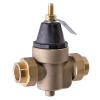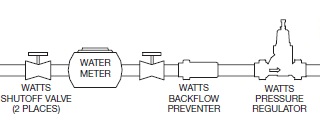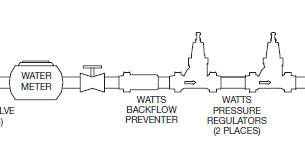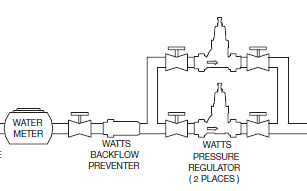 A pressure reducing valve (PRV) is a mechanical device designed to lower the working pressure of a liquid or gas from the supply side to the point of use side in a system. Although pressure reducing valves are used in numerous applications; this article will focus on PRV’s as pertaining to a potable water plumbing system, but they may also be found in hydronics, natural gas, air and steam to name a few.
A pressure reducing valve (PRV) is a mechanical device designed to lower the working pressure of a liquid or gas from the supply side to the point of use side in a system. Although pressure reducing valves are used in numerous applications; this article will focus on PRV’s as pertaining to a potable water plumbing system, but they may also be found in hydronics, natural gas, air and steam to name a few.
Pressure reducing valves operate by using an opposing force to act against the supply water pressure by means of a spring-loaded diaphragm. PRV’s come factory preset to specific ranges but can be adjusted further by placing more or less tension on the spring using an adjustment screw/nut.
When a pressure reducing valve is required
Water distribution systems in most municipalities are spread out over great distances and over various elevations, which force the water purveyor to ensure they provide enough pressure to adequately serve all it’s consumers, but this means that some will likely be connected to a supply that is above optimal operating pressure. Typically people are comfortable with water pressures in the 30-60psi range; hence, most areas have incorporated into their local plumbing code a provision requiring a pressure reducing valve if the supply pressure is above 80psi.
Optionally, pressure reducing valves may be used for water conservation purposes, as limiting the system pressure will reduce the gallons per minute(GPM) / litres per minute(LPM). Reducing your system pressure by as little as 10-20psi could save 1000’s of gallons of water each year.
Choosing a pressure reducing valve
When determining the proper pressure reducing valve for your application a number of factors must be considered; such as:
- Size and type of pipe
- Maximum supply pressure(from the municipality)
- Maximum required system pressure
- Water demand in GPM / LPM
When selecting a PRV the pipe size alone is not necessarily the determining factor so if in doubt read the literature on the valve to see if it will meet your needs.
Pressure reducing valve installations
For most residential applications a single pressure reducing valve will suffice and is installed after the water meter on the system side. There are several connection types available: solder, threaded, pex and quick connect, but as these devices; like all things mechanical, will eventually require maintenance or replacement, an easily removed connection type is generally preferred.

PRV’s in series
When the water service pressure exceeds 200psi, two pressure reducing valves should be installed in series to step down the pressure. This will prolong both the valves serviceability and provide a extra level of safety within your plumbing system.

Parallel pressure reducing valves
Installing pressure reducing valves in parallel offers the ability to service a valve while continuing to provide water to the occupants. Parallel PRV’s are also recommended for buildings with a wide variance of water demand as each PRV can operate at a different pressure setting to provide better performance at peak flow.


